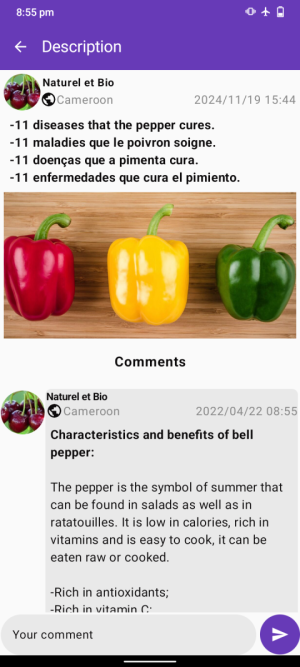Health benefits of pepp or capsican can cure many ailments
Characteristics and benefits of bell pepper:
The pepper is the symbol of summer that can be found in salads as well as in ratatouilles. It is low in calories, rich in vitamins and is easy to cook, it can be eaten raw or cooked.
-Rich in antioxidants;
-Rich in vitamin C;
-Rich in fiber;
- Stimulates intestinal transit;
-Limits the risk of certain cancers.
11 benefits of bell pepper: why eat it?

Antioxidants are compounds that protect cells in the body from damage caused by free radicals. The latter are very reactive molecules that would be involved in the development of cardiovascular diseases, certain cancers and other diseases related to aging. The antioxidant activity of peppers can vary according to their stage of ripening, but also according to their geographical origin, the season and the growing conditions. Green and red bell peppers contain varying amounts of several types of antioxidants such as carotenoids and flavonoids. Red peppers contain more than green ones.

Pepper ranks among the best sources of vitamin C. The content of this vitamin would increase during the ripening of the pepper and would be about twice as high in red peppers as in green ones, which have not reached full maturity. Vitamin C has antioxidant properties and may be partly responsible for the beneficial effects associated with high fruit and vegetable consumption. Vitamin C in the blood helped to reduce oxidation and inflammation in the body, a protective effect against the onset of certain degenerative diseases associated with aging.

Boiled and drained red pepper is an excellent source of vitamin A for women and a good source for men, their needs being different. Raw red pepper is a good source for women and a source for men. Vitamin A is one of the most versatile vitamins, participating in several functions in the body. Among other things, it promotes the growth of bones and teeth, keeps the skin healthy and protects against infections. In addition, it plays an antioxidant role and promotes good vision, especially in the dark.

Raw red pepper is a good source of vitamin B6 while boiled and drained red pepper, green pepper and yellow pepper are sources. Vitamin B6, also called pyridoxine, is part of coenzymes that participate in the metabolism of proteins and fatty acids as well as in the synthesis (production) of neurotransmitters (messengers in nerve impulses). It also contributes to the production of red blood cells and allows them to carry more oxygen. Pyridoxine is also necessary for the transformation of glycogen into glucose and contributes to the proper functioning of the immune system. Finally, this vitamin plays a role in the formation of certain components of nerve cells and in the modulation of hormonal receptors.

Raw green pepper and yellow pepper are sources of manganese for women. Manganese acts as a cofactor for several enzymes that facilitate a dozen different metabolic processes. It also participates in the prevention of damage caused by free radicals.

Raw or boiled and drained green pepper, boiled and drained red pepper, and raw yellow pepper are all sources of copper. As a constituent of several enzymes, copper is necessary for the formation of hemoglobin and collagen (a protein used in the structure and repair of tissues) in the body. Several copper-containing enzymes also contribute to the body's defense against free radicals.

Raw red pepper is a source of vitamin B2, also known as riboflavin. Like vitamin B1, it plays a role in the energy metabolism of all cells. In addition, it contributes to the growth and repair of tissues, the production of hormones and the formation of red blood cells.

Raw red pepper and yellow pepper are sources of vitamin B3 for women. Also called niacin, vitamin B3 participates in many metabolic reactions and contributes particularly to the production of energy from the carbohydrates, lipids, proteins and alcohol that we ingest. It also collaborates in the process of DNA formation, allowing normal growth and development.
Raw red pepper is a source of pantothenic acid. Also called vitamin B5, pantothenic acid is part of a key coenzyme allowing us to properly use the energy present in the food we eat. It also participates in several stages of the synthesis (production) of steroid hormones, neurotransmitters (messengers in nerve impulses) and hemoglobin.

Raw yellow pepper is a source of folate. Folate (vitamin B9) is involved in the production of all cells in the body, including red blood cells. This vitamin plays an essential role in the production of genetic material (DNA, RNA), in the functioning of the nervous system and the immune system, as well as in the healing of wounds and wounds. As it is necessary for the production of new cells, adequate consumption is essential during periods of growth and for the development of the fetus.

Green pepper is a source of vitamin K. Vitamin K is necessary for the synthesis (manufacture) of proteins associated with blood clotting (both stimulation and inhibition of blood clotting). It also plays a role in bone formation. In addition to being found in food, vitamin K is made by bacteria present in the intestine, hence the rarity of deficiencies in this vitamin.







